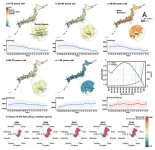(Press-News.org) DALLAS, Feb. 7, 2025 — The American Heart Association’s 2025 Heart Disease and Stroke Statistical Update reports that while progress has been made in reducing cardiovascular and cerebral health disparities, Black communities in the United States still face disproportionately higher risk of heart disease, stroke and hypertension. These gaps subsequently contribute to equally disproportionate high death rates, underscoring the urgent need for lifesaving intervention. As part of its nationwide Heart Month and Black History Month activations, the American Heart Association -- devoted to changing the future to a world of healthier lives for all -- is highlighting the need to close the survival gap through continued education, advocacy and Hands-Only CPR training. The American Heart Association’s goal: ensuring all people, especially those at greatest risk, have the opportunity to live longer, healthier lives.
Addressing the Disproportionate Burden of Cardiovascular Disease
According to the American Heart Association, cardiovascular disease (CVD) remains the leading cause of death in the U.S. The report notes that Black Americans suffer some of the worst CVD health outcomes, likely due to the increasing prevalence of health risk factors that lead to CVD.
CVD Prevalence: Among people aged 20 and older in the U.S., nearly 60% of Black adults have some type of CVD, including coronary heart disease, heart failure, stroke and hypertension; that’s compared to about 49% of all U.S. adults who have some type of CVD.
Stroke Disparities: Among all adults in the U.S., the prevalence of stroke is highest among Black women (5.4%) and Black men (4.8%), compared to all women at 2.9% and all men at 3.6%.
High Blood Pressure Crisis: Black adults in the U.S have some of the highest prevalence of hypertension in the world, with 58.4% of Black women and 57.5% of Black men having high blood pressure. That compares to 50.4% of all U.S. adult men and 43% of all women.
Heart Failure Burden: Black adults account for over 50% of heart failure hospitalizations among U.S. adults under 50.
“The science is clear—Black communities continue to face disproportionate risks of heart disease, stroke, and other cardiovascular conditions, leading to poorer survival outcomes. But data alone won’t drive change,” said Dr. Keith Churchwell, MD, FACC, FACP, FAHA, chief volunteer scientific and medical officer of the American Heart Association. “Real impact happens when we work directly with communities formulating ideas and creating plans and programs to create solutions that address these disparities. By providing access to Hands-Only CPR training, advocating for equitable healthcare, and fostering heart health education, we are committed to working with the community to change the future of health.”
Act and Become a Lifesaver
This February, the Association is challenging families, schools and community organizations to take part in its Hands-Only CPR training initiative and join Nation of Lifesavers™. With nine out of every ten cardiac arrests that happen outside of a hospital resulting in death, learning CPR can double or triple a person’s chance of survival. Only 46% of people who suffer from cardiac arrest receive CPR from a bystander, while CPR is 41% less likely if the person is Black or Hispanic.
“Learning Hands-Only CPR is a simple, powerful step we can all take to save lives. Black History Month serves as a powerful reminder of the resilience and contributions of Black Americans throughout history, as well as the persistent disparities in health that impact Black and Latino communities today,” said Churchwell. “Through the Nation of Lifesavers movement, we’re not only equipping individuals with critical CPR skills, but we’re also working to close the health equity gap, so every individual has the opportunity for a longer, healthier life.”
The Association’s Commitment to Closing the Health Gap
To combat these disparities, the American Heart Association is leading initiatives to:
Expand CPR Education in Black Communities – Encouraging every household to have at least one person trained in Hands-Only CPR to increase survival rates during cardiac emergencies.
Improve Access to Hypertension Management – Raising awareness about the importance of early detection and treatment of high blood pressure, which is a leading cause of stroke and heart disease.
Increase Stroke Prevention Efforts – Providing resources and education about lifestyle changes, early warning signs, and emergency response to reduce stroke-related disabilities and deaths.
Advocate for Equitable Healthcare Policies – Supporting policies that ensure that Black individuals, as much as everyone else, receive timely, high-quality cardiovascular care, including expanding community-based health screenings.
Expanding Heart Health Awareness
To bridge this gap and improve heart health outcomes, the American Heart Association is collaborating with Black-led organizations, Historically Black Colleges and Universities (HBCUs), and community leaders to create and implement culturally relevant solutions to ensure that heart health education reaches those most affected.
Some examples include:
With a commitment to investing in young entrepreneurs, The Association’s EmPOWERED to Serve Business Accelerator™ is a fully remote training and grant opportunity focused on empowering business owners who are focused on equitable health solutions.
The Heart of Innovation HBCU Challenge is a business accelerator opportunity specifically for HBCU undergraduates, graduates and alumni who are developing entrepreneurial technology intended to address the social drivers of health, improve cardiovascular health and/or promote healthy environments. In collaboration with MATTER Heart Health, a global healthcare startup incubator, the American Association will host the Final Virtual Showcase of the four-week Innovation at Heart HBCU Challenge, on Feb. 24.
Historically Black colleges and universities graduate the largest number of African American scholars in the field of medicine. (More than 70% of African American medical professionals earn degrees from HBCUs.) The American Heart Association designed the HBCU Scholars Program to increase the number of HBCU students who can compete successfully for acceptance and matriculation into graduate programs leading to professional degrees in the biomedical and health sciences.
The American Heart Association’s Health Equity in the Workforce initiative, Well-Being Works Better™, in collaboration with the Deloitte Health Equity Institute and the Society for Human Resource Management ( SHRM) Foundation, is convening employers and industry leaders to build a comprehensive roadmap that creates tools, resources and knowledge products to help improve the health and well-being of our nation's workforce.
The American Heart Association’s Social Impact Funds were established to bring equitable health across the board. The Association’s financing fills a critical resource gap for traditionally overlooked and underfunded organizations, and solutions, both for-profit and nonprofit. Providing solutions to aid everyone in overcoming barriers that prevent high-quality, accessible health care, food security and economic empowerment. Since its launch in 2018 and initial community investments in 2019, the American Heart Association’s Social Impact Funds, including the Bernard J. Tyson Impact Fund, have supported more than 100 local social enterprises across the country. Learn more about the American Heart Association Social Impact Funds here.
Additional Resources:
For more information on Hands-Only CPR training and how to get involved, find a nearby class.
Understanding the Importance of the Lay Responder Experience in Out-of-Hospital Cardiac Arrest: A Scientific Statement From the American Heart Association
Difference in Cardiac Arrest vs. Heart Attack
Learn Hands-Only CPR/use an AED (English, Spanish, Mandarin)
AHA health information: Bystander CPR
AHA health information: Bystander CPR Infographic
AHA health information: Hands-Only CPR Resources
Follow AHA/ASA news on X @HeartNews
###
About the American Heart Association
The American Heart Association is a relentless force for a world of longer, healthier lives. Dedicated to ensuring equitable health in all communities, the organization has been a leading source of health information for more than one hundred years. Supported by more than 35 million volunteers globally, we fund groundbreaking research, advocate for the public’s health, and provide critical resources to save and improve lives affected by cardiovascular disease and stroke. By driving breakthroughs and implementing proven solutions in science, policy, and care, we work tirelessly to advance health and transform lives every day. Connect with us on heart.org, Facebook, X or by calling 1-800-AHA-USA1.
END
Cardiovascular health risks continue to grow within Black communities, action needed
CPR training and heart health education remain critical to closing the survival gap and advancing equitable health solutions in Black communities
2025-02-07
ELSE PRESS RELEASES FROM THIS DATE:
ALS survival may be cut short by living in disadvantaged communities
2025-02-07
Living in a disadvantaged community may decrease the length of time a person can survive with amyotrophic lateral sclerosis, or ALS, by over 30%, a Michigan Medicine-led study suggests.
ALS is a progressive, incurable condition that causes muscle wasting and loss of muscle control.
While most people survive with ALS around two to four years, some people can live significantly longer.
In the study of more than 1,000 patients with ALS seen between 2012 and mid-2024, people from the most disadvantaged neighborhoods had up to a 37% ...
No quantum exorcism for Maxwell's demon (but it doesn't need one)
2025-02-07
In a groundbreaking discovery, researchers from Nagoya University in Japan and the Slovak Academy of Sciences have unveiled new insights into the interplay between quantum theory and thermodynamics. The team demonstrated that while quantum theory does not inherently forbid violations of the second law of thermodynamics, quantum processes may be implemented without actually breaching the law. This discovery, published in npj Quantum Information, highlights a harmonious coexistence between the two fields, ...
Balancing the pressure: How plant cells protect their vacuoles
2025-02-07
Plants droop and shed their leaves when parched, but with a splash of water, their stems regain strength and their leaves unfurl. This dramatic transformation is a clear signal for us to reach for the watering can – and it demonstrates a delicate balance at the cellular level, which lies at the heart of plant’s rigidity.
The structural support of a plant depends on the unique balance between two elements: The strong, flexible cell wall provides structural support, while the vacuole, a large cellular compartment filled with water, acts like a water balloon, pressing against the cell wall. The delicate pressure balance between the inside and the ...
Electronic reporting of symptoms by cancer patients can improve quality of life and reduce emergency visits
2025-02-07
CHAPEL Hill, N.C.—People with metastatic cancer who regularly report their symptoms via a home-based electronic monitoring system experienced improved quality of life, clinical outcomes and well-being, as well as fewer emergency department visits than those who didn’t file reports. Both groups had similar overall survival rates, according to University of North Carolina Lineberger Comprehensive Cancer Center researchers and their colleagues.
The results from the national multicenter study appeared in Nature Medicine on Feb. 7.
“Doctors and nurses are often ...
DNA barcodes and citizen science images map spread of biocontrol agent for control of major invasive shrub
2025-02-07
New CABI-led research using publicly-shared DNA barcodes and citizen science images have provided new evidence on the establishment and spread of a biological control agent used for the control of the major invasive shrub Lantana camara.
Lantana camara was introduced as a garden and ornamental plant throughout the tropics and subtropics but is now pervasive throughout the Old World, invading woodlands, forestry, orchards, grasslands, and disturbed areas, where is displaces useful and indigenous plants.
Dr Matthew Cock, CABI Emeritus Fellow, and colleagues took DNA barcodes from the Barcode of Life Data System (BOLD) and citizen ...
Pregnancy complications linked to cardiovascular disease in the family
2025-02-07
Women who have experienced pregnancy complications have an increased risk of cardiovascular disease. Now, a new study from Karolinska Institutet published in the European Heart Journal shows that sisters of women with complicated pregnancies are also at higher risk, even if they had uncomplicated pregnancies. The findings suggest that genes and shared environmental factors may influence the association between pregnancy complications and cardiovascular disease risk.
It is well known that complications during pregnancy, such as high blood pressure and premature labour, increase the risk of cardiovascular disease later in life. However, it is unknown whether ...
Pancreatic cancer immune map provides clues for precision treatment targeting
2025-02-07
Pancreatic cancer patients may benefit from future precision treatments as a new study shows how some tumours may potentially be more susceptible to macrophage-based therapies.
The study which is published in Nature Communications was led by Associate Professor Shivan Sivakumar from the University of Birmingham and Associate Professor Rachael Bashford-Rogers at the University of Oxford and provides the most detailed immune map for pancreatic cancer. The findings suggest that some tumour cells ...
How neighborhood perception affects housing rents: A novel analytical approach
2025-02-07
Housing rents usually correlate with factors such as the building’s age, facilities, and location. Yet not all rentals with similar physical factors charge the same rent. Psychological factors such as the subjective perceptions of the neighborhood matter as well.
Considering these perception variables, an Osaka Metropolitan University team has developed a method with almost 75% accuracy in explaining housing prices in Osaka City.
The team led by Graduate School of Human Life and Ecology student Xiaorui Wang and Professor Daisuke Matsushita used existing Osaka City property datasets and incorporated additional information on the physical factors (sky, vegetation, and buildings) of ...
Many adults report inaccurate beliefs about risks and benefits of home firearm access
2025-02-07
About 40% of households in the United States report firearm access and the majority of firearm owners report typically storing at least one of their firearms unsecured.
The most common reason individuals provide for when asked why they store firearms unsecured is defense, with many reporting that firearms are unrelated to suicide risk despite robust data to the contrary.
A new study by the New Jersey Gun Violence Research Center clarified the extent to which U.S. adults exhibit skewed perceptions of risk and safety by collecting a nationally representative sample of 8,009 adults in May and asking participants about the extent to which they believe ...
Air pollution impacts an aging society
2025-02-07
Air pollution is a growing health issue worldwide, and its impacts are often underestimated in aging societies like Japan. A new study led by researchers from the University of Tokyo highlights how fine particulate pollution, or PM2.5, not only worsens health outcomes, but also creates significant socioeconomic challenges in regions with aging populations and limited medical resources. The researchers hope these findings motivate policymakers to tackle the interrelated issues behind this problem.
PM2.5 refers to microscopic particles of pollution small enough to penetrate deep into the lungs and bloodstream, leading to severe respiratory and cardiovascular ...
LAST 30 PRESS RELEASES:
Hospitals acquired by real estate investment trusts associated with greater risk of bankruptcy, closure
City of Hope scientists study rare disorder to uncover mechanism and hormone regulation underlying fatty liver disease and sweet aversion
Your genes may influence gut microbiome of others, rat study shows
‘Personality test’ shows how AI chatbots mimic human traits – and how they can be manipulated
Global food systems driving twin crises of obesity and global heating
Osaka Medical and Pharmaceutical University researchers capture real-time molecular movies of enzyme catalysis
Could your genes influence the gut microbiome of others?
Clues to Alzheimer’s disease may be hiding in our ‘junk’ DNA
Study reveals that the body uses different sensors to detect cold in the skin and in internal organs
iPS cells from dish to freezer and back
Deep neural networks enable accurate pricing of American options under stochastic volatility
Collective risk resonance in Chinese stock sectors uncovered through higher-order network analysis
Does CPU impact systemic risk contributions of Chinese sectors? Evidence from mixed frequency methods with asymmetric tail long memory
General intelligence framework to predict virus adaptation based on a genome language model
Antibiotic resistance is ancient, ecological, and deeply connected to human activity, new review shows
Vapes, pouches, heated tobacco, shisha, cigarettes: nicotine in all forms is toxic to the heart and blood vessels
From powder to planet: University of Modena engineers forge a low-carbon future for advanced metal manufacturing
Super strain-resistant superconductors
Pre-school health programme does not improve children’s diet or physical activity, prompting call for policy changes, study finds
Autumn clock change linked to reduction in certain health conditions
AI images of doctors can exaggerate and reinforce existing stereotypes
Where medicine meets melody – how lullabies help babies and parents in intensive care
We may never be able to tell if AI becomes conscious, argues philosopher
AI video translation shows promise but humans still hold the edge
Deep ocean earthquakes drive Southern Ocean’s massive phytoplankton blooms, study finds
Without campus leftovers to pick through, the beaks of this bird changed shape during the pandemic
High-dose antibiotic does not reduce mortality in tuberculous meningitis
How many insects fly in the sky above the USA?
Could cheese protect your brain health?
Who faces more difficulty recovering from stroke?
[Press-News.org] Cardiovascular health risks continue to grow within Black communities, action neededCPR training and heart health education remain critical to closing the survival gap and advancing equitable health solutions in Black communities





